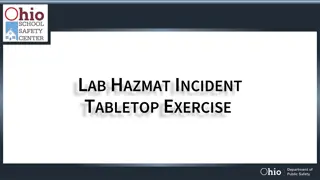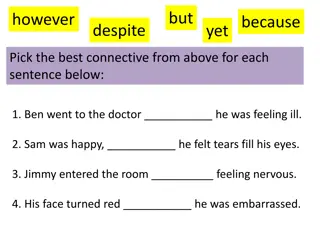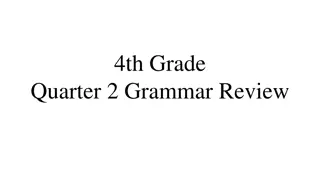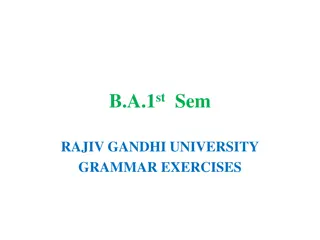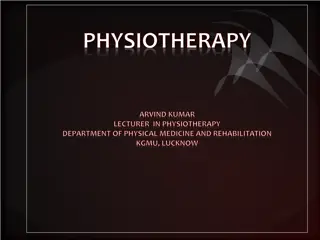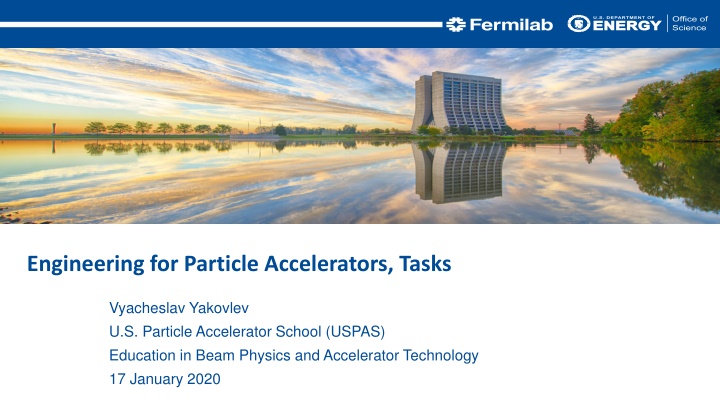
Particle Accelerator Engineering: Tasks and Homework Analysis
Explore the tasks and homework related to particle accelerators, focusing on parameters, operation modes, and energy calculations for SRF cavities in beam physics and accelerator technology. Dive into topics such as cavity design, CW and pulsed operation, energy delivery, dissipation, and acceleration efficiency.
Download Presentation

Please find below an Image/Link to download the presentation.
The content on the website is provided AS IS for your information and personal use only. It may not be sold, licensed, or shared on other websites without obtaining consent from the author. If you encounter any issues during the download, it is possible that the publisher has removed the file from their server.
You are allowed to download the files provided on this website for personal or commercial use, subject to the condition that they are used lawfully. All files are the property of their respective owners.
The content on the website is provided AS IS for your information and personal use only. It may not be sold, licensed, or shared on other websites without obtaining consent from the author.
E N D
Presentation Transcript
Engineering for Particle Accelerators, Tasks Vyacheslav Yakovlev U.S. Particle Accelerator School (USPAS) Education in Beam Physics and Accelerator Technology 17 January 2020
Homework Task 1. SRF 5-cell cavity designed for PIP II has the following parameters: Operating frequency is 650 MHz Acceleration voltage V is 20 MV R/Q is 620 Ohm O0at operation voltage is 3e10 The beam current I is 2 mA Estimate for CW operation: The cavity loaded Q, QL= V/(I (R/Q)) The cavity time constant, = 2QL/ . The cavity bandwidth , f = f/QL; Loss power in the cavity walls; The power transferred to the beam; Power required for refrigeration (conversion factor 1.e3 W/W, i.e., in order to remove 1 W from the cavity wall one needs wall plug power of 1 kW); Acceleration efficiency, the beam power over the sum of the beam power and power required for refrigeration. 2 1/17/2020 V. Yakovlev | Engineering in Particle Accelerators
Homework Task 2. PIP II SRF accelerator will operate CW, but will have capabilities to operate in the pulsed mode as an injector to the booster ring. The beam and cavity parameters are the same as for CW, Task 1. The beam pulse tbeam is 0.55 msec, repletion rate is 20 Hz. The beam appears when the cavity voltage reaches the operating value V, and backward wave (from the cavity to the RF source) is zero. Note that this wave is a sum of the reflection from the coupling element (which is equal to the incident wave), and the wave radiated from the cavity to the line. In the beginning of the cavity filling, the radiation is zero (the cavity is empty), and the backward wave is equal to reflection from the coupling element, and thus, to the incident wave. If there is no beam, the backward wave is again equal to the incident wave (no losses in the cavity) after the voltage reaches its maximal value, but it is again the sum of the wave reflected from the coupling element and radiated wave. It can be only if the radiated wave is two times larger than the wave reflected from the coupling element, and has opposite sign. It means that the beam appears when the cavity field reaches half of the maximal value (zero backward wave, the reflected wave is equal to the radiated wave, and they compensate each other). The cavity voltage, thus, increases during the filling as V(t) =2V(1-exp(-t/ )), is the time constant, = 2QL/ . Filling is over when V(tfill) =V, and therefore, the filling time tfill is equal to ln2. After the beam ends, the RF source is turned off, and cavity discharges as V(t) =Vexp(-t/ ). Thus, the cavity voltage has the following behavior: 3 1/17/2020 V. Yakovlev | Engineering in Particle Accelerators
Homework V(t) =2V(1-exp(-t/ )), t< tfill = ln2 - filling; RF is on, no beam; V(t) =V, the beam acceleration; RF is on; 0<t<tbeam , t=0 corresponds to the end of filling process V(t) =Vexp(-t/ ), cavity discharge; RF is off, no beam. t=0 corresponds to the end of acceleration Estimate: Energy, delivered by the RF source to the beam during the pulse; Total energy, delivered by the RF source during the pulse; Total energy dissipated in the cavity wall during the pulse; Energy, required for refrigeration; Beam power /cavity (20 Hz repetition rate); Average RF power/cavity; Power necessary for refrigeration/cavity; Acceleration efficiency. 4 1/17/2020 V. Yakovlev | Engineering in Particle Accelerators







